warning INFINITI G COUPE 2013 Owner's Guide
[x] Cancel search | Manufacturer: INFINITI, Model Year: 2013, Model line: G COUPE, Model: INFINITI G COUPE 2013Pages: 490, PDF Size: 7.25 MB
Page 57 of 490
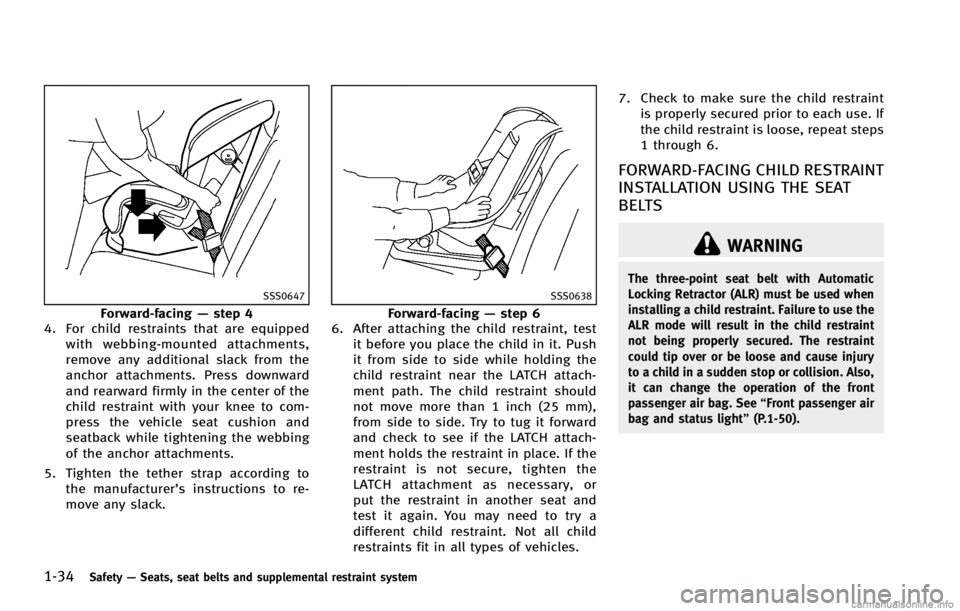
1-34Safety—Seats, seat belts and supplemental restraint system
SSS0647
Forward-facing —step 4
4. For child restraints that are equipped
with webbing-mounted attachments,
remove any additional slack from the
anchor attachments. Press downward
and rearward firmly in the center of the
child restraint with your knee to com-
press the vehicle seat cushion and
seatback while tightening the webbing
of the anchor attachments.
5. Tighten the tether strap according to the manufacturer’s instructions to re-
move any slack.
SSS0638
Forward-facing —step 6
6. After attaching the child restraint, test
it before you place the child in it. Push
it from side to side while holding the
child restraint near the LATCH attach-
ment path. The child restraint should
not move more than 1 inch (25 mm),
from side to side. Try to tug it forward
and check to see if the LATCH attach-
ment holds the restraint in place. If the
restraint is not secure, tighten the
LATCH attachment as necessary, or
put the restraint in another seat and
test it again. You may need to try a
different child restraint. Not all child
restraints fit in all types of vehicles. 7. Check to make sure the child restraint
is properly secured prior to each use. If
the child restraint is loose, repeat steps
1 through 6.
FORWARD-FACING CHILD RESTRAINT
INSTALLATION USING THE SEAT
BELTS
GUID-B0438CCC-C788-4E94-8FA4-DB4F26EE0A33
WARNING
The three-point seat belt with Automatic
Locking Retractor (ALR) must be used when
installing a child restraint. Failure to use the
ALR mode will result in the child restraint
not being properly secured. The restraint
could tip over or be loose and cause injury
to a child in a sudden stop or collision. Also,
it can change the operation of the front
passenger air bag. See “Front passenger air
bag and status light” (P.1-50).
Page 58 of 490

SSS0640
Forward-facing (front passenger seat)—
step 1
Refer to all Warnings and Cautions in the
“Child safety” and“Child restraints” sec-
tions before installing a child restraint.
Follow these steps to install a forward-
facing child restraint using the vehicle seat
belt in the rear seats or in the front
passenger seat:
1. If you must install a child restraint in
the front seat, it should be placed in a
forward-facing direction only. Move the
seat to the rearmost position. Child
restraints for infants must be used in
the rear-facing direction and, therefore,
must not be used in the front seat. 2. Position the child restraint on the seat.
Always follow the child restraint man-
ufacturer’s instructions.
The back of the child restraint should
be secured against the vehicle seat-
back.
If necessary, adjust or remove the head
restraint to obtain the correct child
restraint fit. If the head restraint is
removed, store it in a secure place. Be
sure to reinstall the head restraint
when the child restraint is removed.
See “Head restraints (front seats)” (P.1-
9) for head restraint adjustment, re-
moval and installation information.
If the seating position does not have an
adjustable head restraint and it is
interfering with the proper child re-
straint fit, try another seating position
or a different child restraint.
SSS0360B
Forward-facing —step 3
3. Route the seat belt tongue through the
child restraint and insert it into the
buckle until you hear and feel the latch
engage. Be sure to follow the child
restraint manufacturer’s instructions
for belt routing.
If the child restraint is equipped with a
top tether strap, route the top tether
strap and secure the tether strap to the
tether anchor point (rear seat installa-
tion only). See “Installing top tether
strap” (P.1-38). Do not install child
restraints that require the use of a top
tether strap in seating positions that do
not have a top tether anchor.
Safety —Seats, seat belts and supplemental restraint system1-35
Page 61 of 490
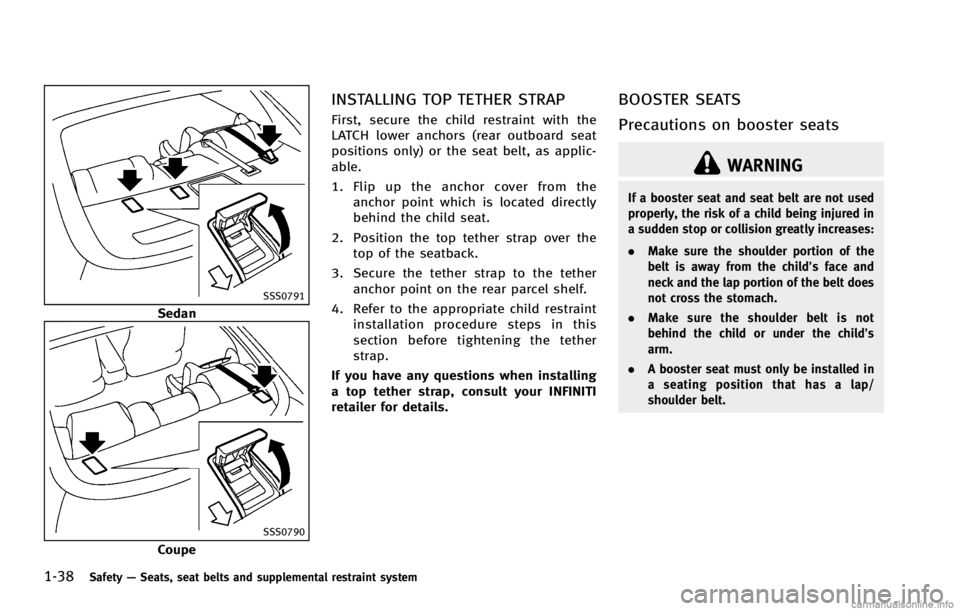
1-38Safety—Seats, seat belts and supplemental restraint system
SSS0791
Sedan
SSS0790
Coupe
INSTALLING TOP TETHER STRAPGUID-C9A5E577-AFA4-46B6-97E2-D077C8A3DBAB
WARNING
If a booster seat and seat belt are not used
properly, the risk of a child being injured in
a sudden stop or collision greatly increases:
. Make sure the shoulder portion of the
belt is away from the child’s face and
neck and the lap portion of the belt does
not cross the stomach.
. Make sure the shoulder belt is not
behind the child or under the child’s
arm.
. A booster seat must only be installed in
a seating position that has a lap/
shoulder belt.
Page 63 of 490
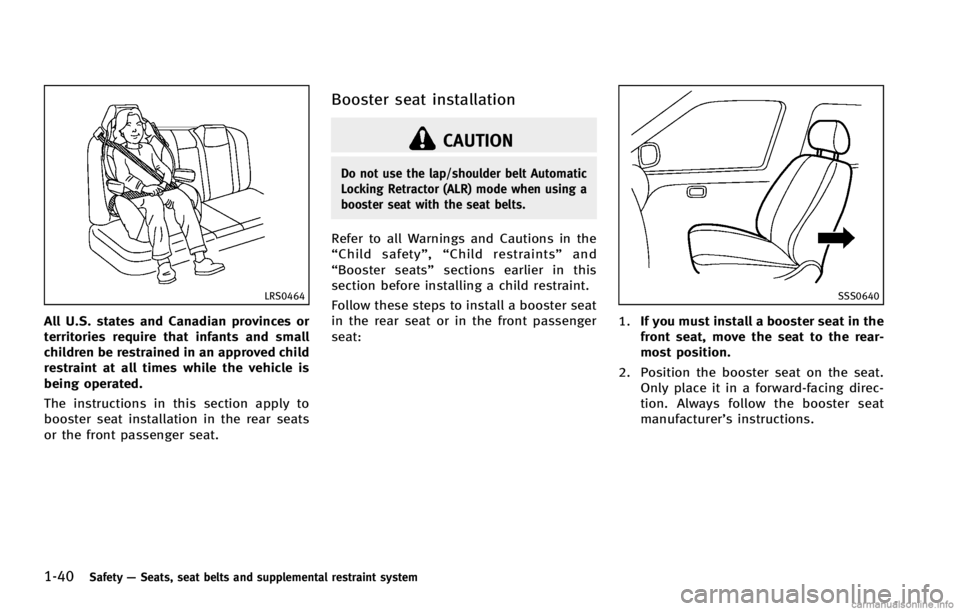
1-40Safety—Seats, seat belts and supplemental restraint system
LRS0464
All U.S. states and Canadian provinces or
territories require that infants and small
children be restrained in an approved child
restraint at all times while the vehicle is
being operated.
The instructions in this section apply to
booster seat installation in the rear seats
or the front passenger seat.
Booster seat installationGUID-F402278F-CB4D-47C2-8CA5-E6E93C16F092
CAUTION
Do not use the lap/shoulder belt Automatic
Locking Retractor (ALR) mode when using a
booster seat with the seat belts.
Refer to all Warnings and Cautions in the
“Child safety” ,“Child restraints” and
“Booster seats” sections earlier in this
section before installing a child restraint.
Follow these steps to install a booster seat
in the rear seat or in the front passenger
seat:
SSS0640
1. If you must install a booster seat in the
front seat, move the seat to the rear-
most position.
2. Position the booster seat on the seat. Only place it in a forward-facing direc-
tion. Always follow the booster seat
manufacturer’s instructions.
Page 64 of 490

LRS0454
Front passenger position
3. The booster seat should be positioned
on the vehicle seat so that it is stable.
If necessary, adjust or remove the head
restraint to obtain the correct booster
seat fit. If the head restraint is
removed, store it in a secure place. Be
sure to reinstall the head restraint
when the booster seat is removed.
See “Head restraints (front seats)” (P.1-
9) for head restraint, removal and
installation information.
If the seating position does not have an
adjustable head restraint and it is
interfering with the proper booster seat fit, try another seating position or a
different booster seat.
4. Position the lap portion of the seat belt low and snug on the child’s hips. Be
sure to follow the booster seat manu-
facturer’s instructions for adjusting the
seat belt routing.
5. Pull the shoulder belt portion of the seat belt toward the retractor to take up
extra slack. Be sure the shoulder belt is
positioned across the top, middle por-
tion of the child’s shoulder. Be sure to
follow the booster seat manufacturer’s
instructions for adjusting the seat belt
routing.
6. Follow the warnings, cautions and
instructions for properly fastening a
seat belt shown in “Seat belts”(P.1-
14).
SSS0676
7. If the booster seat is installed in the front passenger seat, push the ignition
switch to the ON position. The front
passenger air bag status light
may
or may not illuminate depending on the
size of the child and the type of booster
seat used. See “Front passenger air
bag and status light” (P.1-50).
Safety—Seats, seat belts and supplemental restraint system1-41
Page 66 of 490
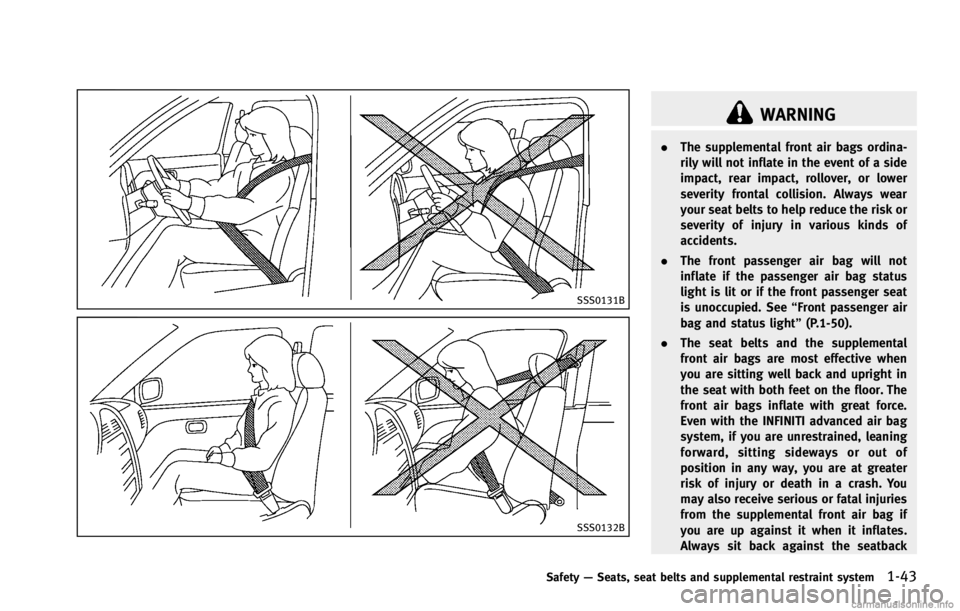
SSS0131B
SSS0132B
WARNING
.The supplemental front air bags ordina-
rily will not inflate in the event of a side
impact, rear impact, rollover, or lower
severity frontal collision. Always wear
your seat belts to help reduce the risk or
severity of injury in various kinds of
accidents.
. The front passenger air bag will not
inflate if the passenger air bag status
light is lit or if the front passenger seat
is unoccupied. See “Front passenger air
bag and status light” (P.1-50).
. The seat belts and the supplemental
front air bags are most effective when
you are sitting well back and upright in
the seat with both feet on the floor. The
front air bags inflate with great force.
Even with the INFINITI advanced air bag
system, if you are unrestrained, leaning
forward, sitting sideways or out of
position in any way, you are at greater
risk of injury or death in a crash. You
may also receive serious or fatal injuries
from the supplemental front air bag if
you are up against it when it inflates.
Always sit back against the seatback
Safety —Seats, seat belts and supplemental restraint system1-43
Page 68 of 490
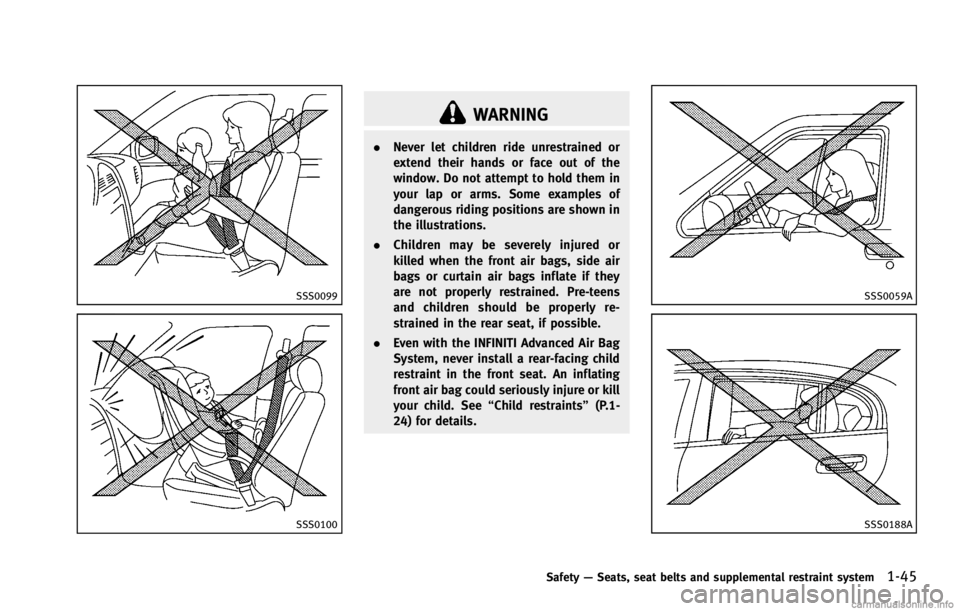
SSS0099
SSS0100
WARNING
.Never let children ride unrestrained or
extend their hands or face out of the
window. Do not attempt to hold them in
your lap or arms. Some examples of
dangerous riding positions are shown in
the illustrations.
. Children may be severely injured or
killed when the front air bags, side air
bags or curtain air bags inflate if they
are not properly restrained. Pre-teens
and children should be properly re-
strained in the rear seat, if possible.
. Even with the INFINITI Advanced Air Bag
System, never install a rear-facing child
restraint in the front seat. An inflating
front air bag could seriously injure or kill
your child. See “Child restraints” (P.1-
24) for details.
SSS0059A
SSS0188A
Safety —Seats, seat belts and supplemental restraint system1-45
Page 69 of 490
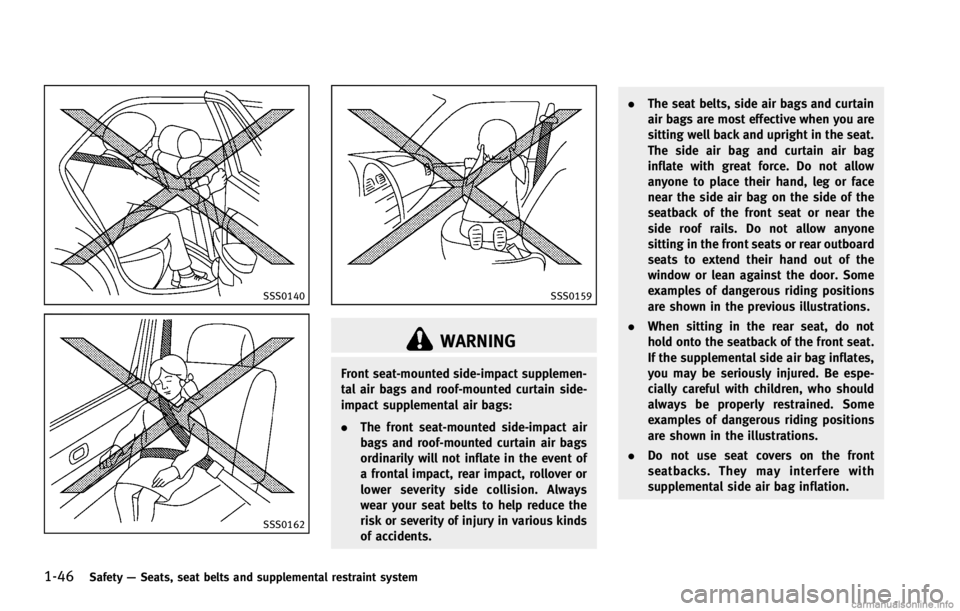
1-46Safety—Seats, seat belts and supplemental restraint system
SSS0140
SSS0162
SSS0159
WARNING
Front seat-mounted side-impact supplemen-
tal air bags and roof-mounted curtain side-
impact supplemental air bags:
. The front seat-mounted side-impact air
bags and roof-mounted curtain air bags
ordinarily will not inflate in the event of
a frontal impact, rear impact, rollover or
lower severity side collision. Always
wear your seat belts to help reduce the
risk or severity of injury in various kinds
of accidents. .
The seat belts, side air bags and curtain
air bags are most effective when you are
sitting well back and upright in the seat.
The side air bag and curtain air bag
inflate with great force. Do not allow
anyone to place their hand, leg or face
near the side air bag on the side of the
seatback of the front seat or near the
side roof rails. Do not allow anyone
sitting in the front seats or rear outboard
seats to extend their hand out of the
window or lean against the door. Some
examples of dangerous riding positions
are shown in the previous illustrations.
. When sitting in the rear seat, do not
hold onto the seatback of the front seat.
If the supplemental side air bag inflates,
you may be seriously injured. Be espe-
cially careful with children, who should
always be properly restrained. Some
examples of dangerous riding positions
are shown in the illustrations.
. Do not use seat covers on the front
seatbacks. They may interfere with
supplemental side air bag inflation.
Page 71 of 490

1-48Safety—Seats, seat belts and supplemental restraint system
SSS0807
Coupe
1. Crash zone sensor
2. Supplemental front air bag modules
(INFINITI Advanced Air Bags)
3. Front seat-mounted side-impact sup- plemental air bags
4. Occupant classification sensor (pat- tern sensor)
5. Occupant classification system con- trol unit
6. Roof-mounted curtain side-impact
supplemental air bags
7. Roof-mounted curtain side-impact supplemental air bag inflators
8. Air bag Control Unit (ACU)
9. Satellite sensors
10. Seat belts with pretensioners
This vehicle is equipped with the INFINITI
Advanced Air Bag System for the driver and
front passenger seats. This system is
designed to meet certification require-
ments under U.S. regulations. It is also
permitted in Canada. However, all of the
information, cautions and warnings in this
manual still apply and must be followed.
The driver supplemental front-impact air
bag is located in the center of the steering
wheel. The front passenger supplemental
front-impact air bag is mounted in the
instrument panel above the glove box. The
front air bags are designed to inflate in
higher severity frontal collisions, although
they may inflate if the forces in another
type of collision are similar to those of a
higher severity frontal impact. They may
not inflate in certain frontal collisions.
Vehicle damage (or lack of it) is not always
an indication of proper front air bag
operation.
The INFINITI Advanced Air Bag System has
dual stage air bag inflators. The system
monitors information from the crash zone
Page 72 of 490

sensor, the Air bag Control Unit (ACU), seat
belt buckle switches and the occupant
classification sensor (pattern sensor). In-
flator operation is based on the severity of
a collision and seat belt usage for the
driver. For the front passenger, the occu-
pant classification sensor is also moni-
tored. Based on information from the
sensors, only one front air bag may inflate
in a crash, depending on the crash severity
and whether the front occupants are belted
or unbelted. Additionally, the front pas-
senger air bag may be automatically turned
OFF under some conditions, depending on
the information provided by the occupant
classification sensor. If the front passenger
air bag is OFF, the passenger air bag status
light will be illuminated (if the seat is
unoccupied, the light will not be illumi-
nated, but the air bag will be off). (See
“Front passenger air bag and status light”
(P.1-50) for further details.) One front air
bag inflating does not indicate improper
performance of the system.
If you have any questions about your air
bag system, contact an INFINITI retailer. If
you are considering modification of your
vehicle due to a disability, you may also
contact an INFINITI retailer. Contact infor-mation is contained in the front of this
Owner’s Manual.
When a front air bag inflates, a fairly loud
noise may be heard, followed by release of
smoke. This smoke is not harmful and does
not indicate a fire. Care should be taken
not to inhale it, as it may cause irritation
and choking. Those with a history of a
breathing condition should get fresh air
promptly.
Front air bags, along with the use of seat
belts, help to cushion the impact force on
the head and chest of the front occupants.
They can help save lives and reduce
serious injuries. However, an inflating front
air bag may cause facial abrasions or other
injuries. Front air bags do not provide
restraint to the lower body.
Even with INFINITI advanced air bags, seat
belts should be correctly worn and the
driver and passenger seated upright as far
as practical away from the steering wheel
or instrument panel. The front air bags
inflate quickly in order to help protect the
front occupants. Because of this, the force
of the front air bag inflating can increase
the risk of injury if the occupant is too
close to, or is against, the air bag module
during inflation.The front air bags deflate quickly after a
collision.
The supplemental front air bags operate
only when the ignition switch is in the ON
position.
After pushing the ignition switch to the ON
position, the supplemental air bag warn-
ing light illuminates. The supplemental air
bag warning light will turn off after about
7 seconds if the system is operational.
Safety
—Seats, seat belts and supplemental restraint system1-49